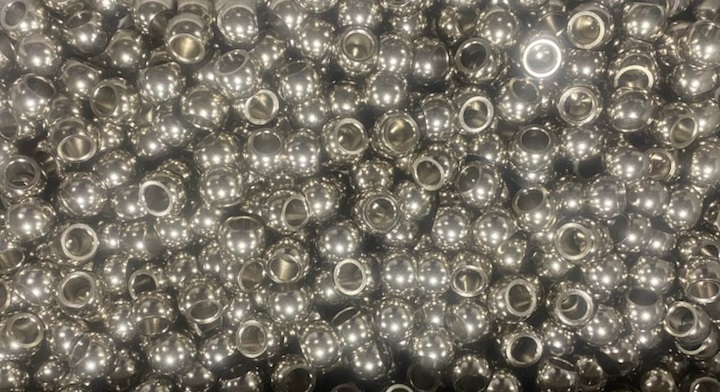6 Types of Metal Finishes For Close Tolerance Applications
1. Zinc Electroplating
Zinc electroplating is an electrolytic or “electro-deposition” process that helps in close-tolerance applications where excessive corrosion, wear, and thermal stresses are expected. As with all electroplating processes, the base metal is bathed in a specially-formulated ionic solution (zinc in this case). Then, an electrical current is passed through the bath, causing a thin layer of zinc coating to be deposited on the surface of the base metal.
Aerospace has transitioned some cadmium plating work over to zinc plating for exposed parts where corrosion protection is critical, such as landing gear, turbines, and fasteners. A zinc electroplate reduces friction, abrasion, and wear rate, which can help in close tolerance applications such as threaded nuts, bolts, fasteners, and other small metal parts.
While covering power is outstanding, it can be challenging to achieve consistent thickness in a zinc electroplate.
2. Cadmium Electroplating
An option for the most demanding of industrial conditions, cadmium electroplating is used on a wide range of parts in aerospace, military, mining, and aviation applications. Due to the excellent lubricity of a soft white cadmium metal coating, cad electroplate eliminates stick-slip issues under torque (such as with plated threads and similar close-tolerance applications).
Cadmium is also useful for corrosion or wear resistance, strong conductivity, and cosmetic appeal on parts from fasteners to chassis to connectors and electrical components.
3. Nickel Sulfamate Electroplating
A sulfamate nickel electroplate is among the most common types of metal finishes for industrial applications of nickel plates. It’s also unique in that it can be used to apply unusually thick nickel deposits (of an inch or more).
However, even in close-tolerance applications, nickel sulfamate electroplating plays an important role with fast, reliable, and highly consistent results. The excellent ductility and elongation properties prevent this plate from suffering deformation or stress cracking under harsh forces. A low-stress nickel deposit can substantially reduce peeling, cracking, crazing, warping, blistering, distortion, and shrinkage often seen in other metal finishing techniques for close tolerance.
4. Electroless Nickel Plating
The electroless deposition process is purely chemical and results in a much more uniform nickel deposit than an electrolytic process — an important advantage for close-tolerance applications. Electroless nickel plating is used for carefully finished products that range from common household goods (knives, forks, bathroom fixtures) to industrial and military equipment, paper-making machinery, transportation equipment, and oil field parts.
The biggest benefit of electroless nickel (EN) is that it does not “dog bone,” a common issue with electroplating. Electrolytic nickel plating tends to be non-uniform. Excess deposits can form on edges or convex corners of the substrate because the electrical current is typically higher in those areas. Additionally, less material tends to be deposited in holes, recesses, and concave corners.
With the electroless chemical process, the plate is uniformly deposited, eliminating the need for post-plate machining on critical dimensions. The ability to plate irregular surfaces evenly with a uniform plate thickness makes EN ideal for close tolerance applications.
This process works with a variety of metallic substrates. Aluminum, copper based alloys, nickel based alloys, ferrous alloys and zinc die cast can all be plated with electroless nickel.
5. Electropolishing
In a close tolerance scenario, not all types of metal finishes are about adding material. Sometimes the finish is about smoothing out imperfections and impurities for a smooth, perfectly formed surface.
Electropolishing is a cleaning process that essentially functions in the opposite way of electroplating. An electrical current is still applied to the metal, but rather than attracting and depositing a surface coating, a small surface layer is removed (and along with it, any impurities that may have contaminated the surface).
This levels out microscopic peaks and valleys and results in a uniform surface with an exceptionally smooth and clean finish that is easily sterilized. Surgical devices are therefore excellent candidates. Small and irregularly shaped objects as well as larger and more symmetrical substrates can all undergo electropolishing.
6. Superfinishing
A superfinish is all about polishing to a perfect sheen and minimizing friction or imperfections in close tolerance uses. The highest industry standard of isotropic metal super finishes can micro-polish a metal surface finish down to an Ra value of 2 µin. MFT has nationally recognized capabilities for close tolerance super finishing services on a variety of metals, including parts for aerospace OEMs, medical hardware, and commercial or electrical components.
Looking for one of these kinds of finishes? Get in touch with our team for a rapid quote turnaround!

